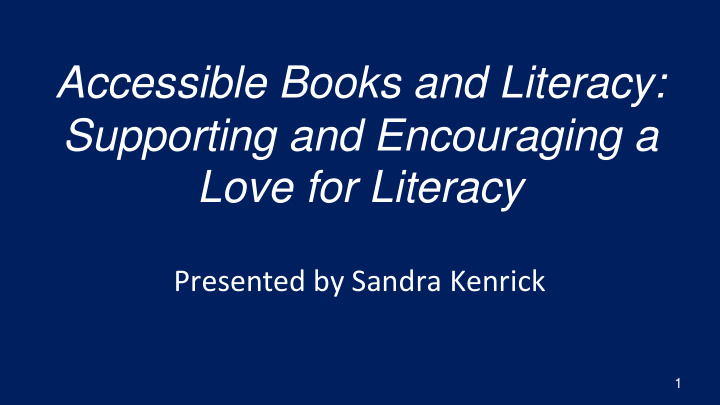



Accessible Books and Literacy: Supporting and Encouraging a Love for Literacy Presented by Sandra Kenrick 1
Introduction 2
Meeting Liam 3
How did I get started ‘creating accessible books’? 4
Sharing ideas and stratgies... Perkins School for the Blind and Texas School for the Blind and Visually Impaired http://www.pathstoliteracy.org/users/liamsmom 5
Accessible Environment Home School Church Community 6
Making the Environment Accessible ● Label the home and classroom with braille, large print and tactile symbols ● All children need a literacy-rich environment in a format that is accessible to them 7
8
9
10
11
12
13
Community: Church, stores, resteraunt etc... 14
Need for Accessibility 15
Overview of Different Approaches Experience Books Conversation Boxes Story Boxes or Story Bags Tactile Books Adapting Classroom Readers Adapting Science Books / Non-Fiction Readers 16
Experience Books 17
How to Create an Experience Book Using actual ‘mementos’ from the experience Plan ahead! What is the experience? What activities/steps do you want to highlight in the book? (What do you think would be the most memorable and meaningful-take note of things to remember to collect) Bring a bag to collect objects to represent the the activities from the experience (ie: feeding the goats at the farm--pieces of goat feed or hay) If child is not present to make the book, it can be made when he/she is not there. 18
Bowling ‘book’ Objectives: -Liam will be able to use the bowling book as a tool to share his experience. -Liam will be able to read the story himself using contractions like, can, go, and I that he has been learning at school. Options for modified objectives: -Use focus vocabulary -Communication goals -Organizing a story/sequencing -Writing/retelling an event 19
Bowling Event: Creating an Experience Book Event: Bowling Experiences Liam enjoyed during bowling: 1. He ate pizza and drank pop. 2. He got to wear bowling shoes. 3. He was able to carry his bowling ball to the ‘ramp’ and push the ball. 4. He got to feel a ‘big pin’ and the little toy ‘pins’ and ‘ball’. 5. He visited with friends. 20
Bowling Experience Book 21
Opportunity to Share: Reading With Grandma 22
Experience Book About Trains 23
Conversations Boxes What is a conversation box? A box of items (in this case, items about a shared experience), that a learner can use to have a conversation with someone about the items. 24
Another example of a Conversation Box 25
Story Boxes A story box is a collection of objects/symbols that are used in telling a story. 26
27
28
Sharing Time: Utilizing your story box 1. Organize 2. Explore and introduce 3. Tell the story 4. Child shares 29
Tactile Books and Concept Books 30
31
Adapting Classroom Readers 32
Additional examples of adapting Classroom Books: 33
Tactile Graphics 34
Adapting Science Books / Non-Fiction Readers Bird Book Life Cycle Book 35
Braille Word Dictionary ● Add words that are motivating! ● Good for review of words that have been learned 36
Supporting IEP Goals ● Make books that give your child practice with the objectives from the IEP ● Choose motivating topics! ● “Mom’s New Car” gives practice using adjectives ● “Fridge” gives practice categorizing things 37
Where to get books? ● Host a Book-Making Party! Get friends and family involved! 38
Materials: Ideas for book pages Sturdy pages to support tactile ‘pictures’: - Chipboard pages/books - Card stock pages - File folders: place in a binder - ’Re - use’ children’s board books 39
Specific Ideas for Kids Who Are Deafblind Remember to provide access to ASL! Story Telling Homework Table 40
Review! 1. Accessible Environment 2. Experience Books 3. Story boxes and Conversation Boxes 4. Tactile Graphics 41
http://www.pathstoliteracy.org/users/liamsmom 42
Q & A Session with Sandy Kenrick 43
Thank You! 44
Recommend
More recommend